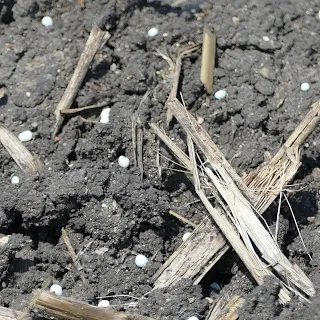 |
| Image credit: Daniel Kaiser/University of Minnesota Extension |
By: Extension specialists Daniel Kaiser, Lindsay Pease, and Fabian Fernandez
With fall winding down and the hard winter freeze setting in, growers may be asking if fall tillage is an option for some fields. While there are pros and cons in terms of soil conservation, when it comes to fertilizer application, tillage is a good option for broadcast and other surface applications.
Plant nutrients need time to react with the soil in order to reduce the potential for off-target movement. The amount of time needed can vary by nutrient. Commercial fertilizer sources are highly water-soluble but can still take a few days to weeks in order to reduce the risk of nutrient movement off the field. As we push further into the fall and soils freeze, they become impermeable and nutrients cannot move downward into the soil profile as easily.
The potential for loss of nutrients broadcast on the soil surface increases if there is substantial water movement across the soil surface. For example, phosphorus fertilizer movement tends to be greatest when rainfall occurs in the first five days following a broadcast application.
In contrast to phosphorus, nitrogen can be lost in water or in the air. If there is no way to incorporate urea into the soil due to frozen conditions, then it should not be applied because the available nitrogen will be lost either in runoff or through volatilization of ammonia. Research has shown up to 45% loss of N from urea due to volatilization alone when applied to frozen ground.
Tillage is an optimal management strategy to incorporate fertilizer or manure into the soil to help increase the potential for reaction with the soil, but the risk of fertilizer loss needs to be weighed against the potential that tillage will increase soil erosion. However, if soils are frozen, the reaction of the fertilizer with the soil may be limited, even if tillage is possible. Roughing up the soil surface with tillage could slow water movement but may not eliminate the risk for nutrient loss. Getting the fertilizer off the soil surface does have benefits, even though some volatilization and leaching may still occur.
If things get too late and you are questioning whether to apply fertilizer, it is better to wait until spring. Otherwise, you will be putting your investment at risk for moving within—or off—your field into areas where it is not needed.
---
For the latest nutrient management information, subscribe to Minnesota Crop News email alerts, like UMN Extension Nutrient Management on Facebook, follow us on Twitter, and visit our website.
Support for this project was provided in part by the Agricultural Fertilizer Research & Education Council (AFREC).
With fall winding down and the hard winter freeze setting in, growers may be asking if fall tillage is an option for some fields. While there are pros and cons in terms of soil conservation, when it comes to fertilizer application, tillage is a good option for broadcast and other surface applications.
Plant nutrients need time to react with the soil in order to reduce the potential for off-target movement. The amount of time needed can vary by nutrient. Commercial fertilizer sources are highly water-soluble but can still take a few days to weeks in order to reduce the risk of nutrient movement off the field. As we push further into the fall and soils freeze, they become impermeable and nutrients cannot move downward into the soil profile as easily.
The potential for loss of nutrients broadcast on the soil surface increases if there is substantial water movement across the soil surface. For example, phosphorus fertilizer movement tends to be greatest when rainfall occurs in the first five days following a broadcast application.
 |
| Image credit: Paul McDivitt |
Tillage is an optimal management strategy to incorporate fertilizer or manure into the soil to help increase the potential for reaction with the soil, but the risk of fertilizer loss needs to be weighed against the potential that tillage will increase soil erosion. However, if soils are frozen, the reaction of the fertilizer with the soil may be limited, even if tillage is possible. Roughing up the soil surface with tillage could slow water movement but may not eliminate the risk for nutrient loss. Getting the fertilizer off the soil surface does have benefits, even though some volatilization and leaching may still occur.
If things get too late and you are questioning whether to apply fertilizer, it is better to wait until spring. Otherwise, you will be putting your investment at risk for moving within—or off—your field into areas where it is not needed.
---
For the latest nutrient management information, subscribe to Minnesota Crop News email alerts, like UMN Extension Nutrient Management on Facebook, follow us on Twitter, and visit our website.
Support for this project was provided in part by the Agricultural Fertilizer Research & Education Council (AFREC).
This article was first published in November 2019.
Comments
Post a Comment